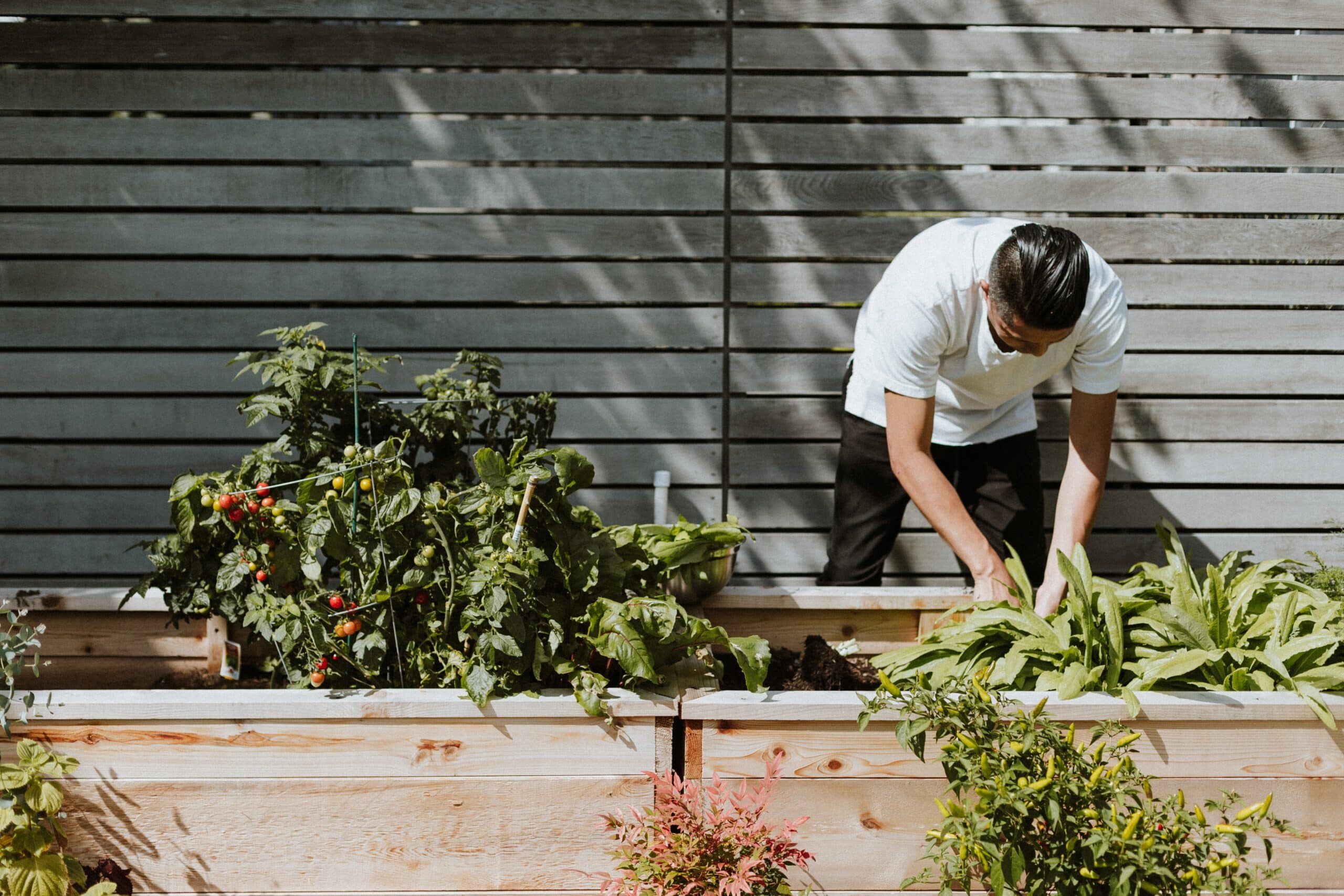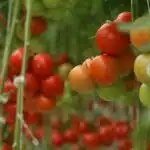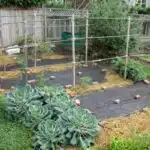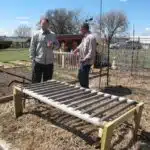Planting tomatoes is like a game of chess – precisely planned moves and calculated risks are necessary to ensure a successful harvest. Whether you’re an experienced green thumb or starting your gardening journey, growing tomatoes requires knowledge and dedication. As the popular saying goes, “the best time to plant a tree was 20 years ago. The second best time is now.” With this helpful guide, you can begin planting your own tomato crop and enjoy the fresh, juicy fruits of your labor in no time.
Tomatoes are one of the most popular vegetables to grow in gardens worldwide due to their flavor, versatility in cooking, and abundance of health benefits. For novice gardeners who are ready to take on the challenge of growing tomatoes, there are several key steps that must be taken in order to make sure your plants thrive. From selecting the right type of soil and fertilizer to understanding when and how much to water your plants, following these tips will help ensure you have a bountiful harvest at the end of the season.
Growing tomatoes isn’t as difficult as one might think with the proper knowledge and supplies – it just takes some patience and commitment from start to finish. In this article, we’ll cover everything from what type of tomato variety is best for your garden to how often they should be watered during peak growth season. By following these simple instructions, you’ll be able to enjoy fresh homegrown tomatoes all throughout summer!
Choosing The Right Tomato Varieties
Choosing the right tomato variety for your garden is essential for successful growth and delicious tomatoes. Deciding which varieties to grow can be daunting, but it doesn’t have to be. With a little research and knowledge, you’ll be able to choose the best tomatoes for your garden.
When selecting tomato varieties, consider what type of tomatoes you’re looking for–cherry, heirloom, or beefsteak? Consider how many plants you need and how much space they will take up in the garden. Additionally, think about when you want to harvest them–early in the season or later? Knowing all of these things can help narrow down your choices so that you can pick the perfect ones for your garden.
Once you’ve made a decision on what types of tomatoes to plant, it’s time to prepare the soil. Researching soil pH levels, composting techniques, and fertilizers are key steps that will ensure your tomato plants get off to a good start in their new home.
Preparing The Soil
Planting a garden is like baking the perfect cake. It requires just the right ingredients and the ability to layer them in to make something that will truly flourish. When it comes to planting tomatoes, preparing the soil is one of those key components for success.
Before sowing any tomato seeds, it’s important to give the soil some TLC. Adding organic matter such as compost or manure helps keep moisture and adds vital nutrients for your plants. Working the soil with a shovel or hoe also helps loosen it up and make it easier to work with when planting. If your soil has a high clay content, consider adding gypsum or vermiculite to help improve its structure.
When you’re ready to start planting, test the soil pH level to ensure it’s between 6-7 as tomatoes flourish in slightly acidic conditions. If needed, adjust by adding lime or other materials recommended by your local nursery or extension office before sowing the seeds. With these tips in mind, you can be sure that your tomato plants will have all they need for an abundant harvest!
Sowing The Tomato Seeds
The tomato seeds are ready to be planted, and the anticipation of a fresh harvest is growing. Envisioning the luscious, ripe tomatoes in your hand, you feel motivated to get started with sowing the seeds.
With careful consideration of the soil’s quality and moisture, it’s time to sow the tomato seeds. You can do this by sprinkling them over the prepared soil or planting them in rows. If you choose to plant in rows, make sure they are at least 2 feet apart as they will need room to grow. When placing each seed into the soil, aim for one-inch depths.
Once all of your tomato seeds are planted, cover them lightly with more soil and water them gently until moist. As you step back and admire your work, keep in mind these tiny seeds will soon become thriving and healthy tomato plants – just wait and see! Now that the sowing has been taken care of, it’s time for transplanting tomato seedlings for even more growth potential.
Transplanting Tomato Seedlings
Transplanting tomato seedlings is a vital part of growing tomatoes. It’s the moment when you take your little seedlings from the safety of their starting bed and give them a chance to grow in the wild world of your garden. Imagine it like sending your kids off to college; you’ve done all you can to prepare them, but now they have to go out and make it on their own.
Before transplanting, it’s important to harden off your seedlings by gradually increasing exposure to outdoor conditions over a period of 10 days or so. This helps the plants adjust to their new environment without shock or stress. You can also trim away any excess foliage to redirect energy into root growth for a healthier plant overall.
Once your seedlings are ready for the big move, choose an area that receives at least 6 hours of direct sunlight each day and has well-draining soil. Plant them deep enough so that two-thirds of each stem is buried in the dirt – this encourages strong root systems which will support healthy growth in the future. With these simple steps, you’ll soon be ready for the next step: caring for those tomato plants!
Caring For The Tomato Plants
Caring for the tomato plants is an important part of the growing process. With a few simple steps, you can ensure they live a long and healthy life.
The most important thing to do is make sure your plants get enough sunlight. They need at least six hours of direct sunlight each day to thrive. Additionally, it’s important to thin out extra seedlings when transplanting, so that your tomatoes have plenty of room to grow. Pruning off any unhealthy leaves or stems will also help promote healthy growth.
Finally, be sure to monitor the soil moisture levels in your garden. The soil should be moist but not waterlogged, as this can lead to root rot and other diseases in the plants. Once your tomato plants are established, you can begin watering them regularly and fertilize them as needed.
Watering And Fertilizing Tomatoes
Watering and fertilizing are integral parts of tomato plant care. Applying the right amount of water and fertilizer can help keep tomatoes healthy and productive all season long. When it comes to watering tomatoes, it’s important to establish a regular schedule. The soil should remain moist but not soggy. Avoid getting the leaves wet when watering, as this can cause disease.
Fertilizing is also important for tomato plants. To ensure your plants get the proper nutrients they need, use a slow-release fertilizer at planting time. Then, after the first fruits appear, switch to a liquid fertilizer that’s high in nitrogen and potassium. Remember to follow the directions on the packaging for accurate application rates.
Regularly monitoring your tomato plants can help you identify any issues before they become serious problems. Check for signs of nutrient deficiencies or possible pests like aphids or whiteflies that may be affecting your plants’ health. Taking preventative measures now can save you from bigger headaches down the road. With careful attention to watering and fertilizing needs, you’ll be rewarded with an abundant harvest of delicious tomatoes!
Pruning And Training Tomatoes
As we come to the end of our tomato-growing journey, it’s time to address pruning and training. Pruning your tomatoes is an essential step in ensuring their healthy growth and subsequent yield. It helps promote air circulation and sunlight penetration and can also help reduce disease pressure.
When it comes to pruning, there are several techniques you can use. If you’re growing indeterminate tomatoes, pinch off the suckers that appear in between the branches and main stem. For determinate varieties, trim away any side shoots that develop after flowering has begun. You should also remove any leaves that are obstructing sunlight or air flow to the plant’s center or lower branches.
Finally, training your plants is an important part of helping them reach their full potential. When plants start to get too tall for their own good, consider using stakes, cages or trellises as support structures so they remain upright throughout growth season. Doing this will help maximize fruit production while keeping foliage from taking over your garden beds. With these steps in mind, we’ll now turn our attention to disease prevention and control for a bumper crop of tomatoes!
Disease Prevention And Control
Growing tomatoes is like playing a game of chess: it requires careful planning and strategic moves. Disease prevention and control is an essential part of the process, helping your plants to remain strong and healthy. Just like in chess, you have to think several moves ahead; if you don’t plan for potential issues, they may come back to haunt you later.
There are several things you can do to prevent disease in your tomatoes. Start by providing well-drained soil with plenty of organic matter. You should also rotate your crops from season to season so that diseases don’t build up over time in the same space. Additionally, it’s important to avoid wetting the leaves when watering your tomatoes as this can lead to fungal infections.
To get ahead of any potential issues, regularly inspect your plants for signs of disease such as yellowing leaves or spots on the fruit or stems. If you notice any unusual patterns, take steps immediately to address them before they become a larger problem. This could include removing diseased plants and using pest control methods such as insecticides or fungicides when necessary. Taking these proactive steps will go a long way towards protecting the health of your tomato plants and ensuring a successful harvest down the line. With diligent oversight and preventive measures in place, weeds won’t stand a chance against your thriving garden!
Controlling Weeds
Once your tomato plants are in the ground, it’s time to think about controlling weeds. Weeds compete with tomatoes for nutrients, sunlight, and water, so it’s important to remove them regularly before they can get too big. There are a few different ways to do this.
One option is to use hand-pulling. This involves physically pulling the weeds up from the roots by hand. It’s an effective way of removing small weeds and those that have just started sprouting in the garden bed. It’s also relatively easy and inexpensive, making it a great choice for beginner gardeners.
Another way to control weeds is by using herbicides or weed killers. These chemicals will kill existing weeds as well as prevent new ones from growing in the future. However, you should use caution when applying these products since they can also harm other nearby plants if not used properly.
It’s also beneficial to mulch around your tomato plants after planting them in order to help suppress weed growth and retain moisture in the soil at the same time.
Mulching
Mulching tomatoes is like wrapping them up in a cozy blanket – it protects them from the elements, helps retain moisture and can even lead to bigger harvests. It’s an essential step for ensuring your tomato plants thrive throughout the growing season.
When mulching tomatoes, use either straw or grass clippings. Spread it around the base of the plant and make sure it’s about four inches deep. This will help keep weeds away by blocking out light and prevent soil erosion due to wind and water runoff. Plus, mulch helps maintain consistent soil temperatures so that your tomatoes can develop into delicious fruits.
For optimum growth, be sure to add fresh mulch every month or so during the growing season. Doing this will help keep weeds at bay while also providing nutrients to your tomato plants as they break down over time. With regular mulching, you’ll be well on your way towards harvesting a bumper crop of juicy tomatoes!
Harvesting Tomatoes
Harvesting tomatoes is an exciting step in the growing process! You’ll need to be vigilant and watch for the signs that your tomatoes are ripe. Generally, you should wait for the tomato to turn a deep red color and feel slightly soft when touched. If you’d like to pick them at a more immature stage, look for ones that have started to change color from green to pink or red.
When harvesting tomatoes, it’s important to use a gentle touch. Gently twist the fruit off of the stem and avoid pulling on it as this can cause damage to both the plant and the fruit itself. Don’t forget to check for any insects or pests – if there are any present, you may want to spray your tomato plants with an insecticide before harvesting.
Once harvested, it’s time to enjoy your delicious homegrown tomatoes! But don’t forget – tomatoes don’t stay fresh forever. Storing them in a cool place away from direct sunlight will help keep them fresher longer.
Storing Tomatoes
Once the fruits of your labor are ready for harvest, it’s time to move onto storing tomatoes. This step is essential to ensure you get the most out of your hard work.
The best way to store your tomatoes is to keep them away from direct sunlight and in a cool, dry place. This can be a cabinet or pantry in your kitchen, or any other room in your home. Make sure there is plenty of air circulation around the tomatoes, as this will help keep them fresh longer. Additionally, avoid storing them near ethylene-producing foods like apples and bananas since they can cause the tomatoes to spoil faster.
When stored correctly, tomatoes can last up to two weeks in ideal conditions. However, if you need to store them for longer than that, freezing or canning them may be a better option. Whichever method you choose, make sure you take extra care when handling the tomatoes to prevent bruising and mold growth.
With proper storage techniques, you’ll be able to enjoy your homegrown tomatoes for weeks after harvesting!
Common Tomato Pests
It’s a jungle out there – and we’re not just talking about your garden! With the perfect combination of soil, water and sunlight, your tomatoes can thrive, but they may also fall victim to pesky pests. Like Jack and the Beanstalk, it’s time to tackle these little critters before they take over. Let’s explore the common tomato pests.
Just like with any other plant, tomatoes can succumb to many different types of insects. From aphids and leafhoppers to flea beetles and cutworms – these little buggers will stop at nothing to feast on your precious veggies! Fortunately, there are some simple steps you can take to protect your tomatoes from becoming an all-you-can-eat buffet for pests.
When scouting for potential intruders, inspect both the leaves and fruit of each plant in your garden. If you find any signs of an infestation (such as holes in the leaves or discoloration), remove affected plants immediately and dispose of them away from your garden. Additionally, make sure you keep up with regular maintenance such as weeding and mulching around your plants – this will help to discourage pests from invading your tomato patch.
By taking proactive steps like these, you’ll be better equipped to combat an invasion of unwanted critters so that you can enjoy a delicious harvest of tomatoes! Now that we’ve tackled common tomato pests, let’s move on to addressing common tomato diseases…
Common Tomato Diseases
Growing tomatoes can be a rewarding experience, with their succulent sweetness adding flavor and color to your summer meals. But while they’re easy to start, they can face certain challenges along the way. One of these is common tomato diseases.
The most common diseases that affect tomatoes are early blight, powdery mildew, gray leaf spot, and septoria leaf spot. Early blight is caused by a fungus and usually appears as dark-colored spots on the leaves or stems of the plant. Powdery mildew shows up as white patches on the leaves and stems of tomatoes and can cause them to become stunted in growth. Gray leaf spot causes circular spots with yellow halos on the foliage of plants, while septoria leaf spot will produce small dark spots surrounded by yellow halos on both sides of tomato leaves.
To help prevent these diseases, keep your garden free from weeds or old plant debris which could harbor disease spores; avoid wetting foliage when watering; use mulch around plants to help retain moisture; and rotate different crops in your garden each year to prevent buildup of fungal organisms in the soil. Taking these steps will help protect your precious tomato crop throughout the season.
Troubleshooting tips can help you make sure your tomato plants stay healthy all season long.
Troubleshooting Tips
Troubleshooting tips are essential to help you get the most out of your tomato-growing experience. To ensure that your tomatoes thrive, it’s important to stay on top of potential problems and be proactive in addressing them. In this section, we’ll discuss some common issues and how to best tackle them.
The first step is recognizing when something is amiss. Look for signs such as discoloration or wilting leaves, and inspect your plants regularly for pests or disease. If you suspect any issues, take action immediately by removing affected plants, treating them with organic products if needed, and monitoring the area for further outbreaks.
In addition to being proactive, it’s also beneficial to give your tomatoes proper care throughout their life cycle. Make sure they are planted in well-draining soil, watered regularly (but not too much), and fertilized occasionally. With these steps in place, you can rest assured that your plants will remain healthy and productive.
Frequently Asked Questions
What Is The Best Time Of Year To Plant Tomatoes?
Planting tomatoes is an exciting and rewarding experience, especially when you get to enjoy them in the summertime. Knowing when the best time of year is to plant tomatoes can make all the difference in getting a successful harvest.
Generally speaking, it’s best to plant tomatoes in late spring or early summer. That way, they’ll have plenty of time to mature and bear fruit before the days start getting shorter and cooler in the fall. However, if you live in a warm climate, you may be able to plant your tomatoes as early as January or February. Just make sure that night-time temperatures stay above 55 degrees Fahrenheit so your plants don’t suffer from frost damage.
When planting tomatoes, give them plenty of sun throughout the day and provide them with good drainage. You’ll also want to make sure there’s enough space between each plant for air circulation and growth – at least one foot apart! Finally, don’t forget to water them regularly and keep up with pruning and weeding so they can reach their full potential. With these tips in mind, you’ll be well on your way to growing juicy tomatoes that will taste great all season long!
How Often Should I Water My Tomato Plants?
Planting and growing tomatoes is like a dance; each step needs to be done in perfect harmony with the others for the best results. One of those steps is watering, and that’s what we’ll focus on here. How often should you water your tomato plants?
The answer depends on several factors, including the size and age of the plants, as well as how much sunlight they’re getting. Generally speaking, young plants need to be watered every two or three days. As they get older, you can cut back to once a week; however, if there’s been a lot of rain in your area, you may not need to water them at all.
It’s also important to make sure you’re giving your tomatoes enough water but not too much. Overwatered plants can develop root rot and become susceptible to diseases like fungus and blight. Too little water can cause fruit to drop prematurely or fail to reach its full size potential. To ensure healthy growth, check your soil for moisture with your finger before giving your plants a drink.
Watering correctly will help keep your tomato plants happy and productive throughout the growing season – providing you with juicy fruits for salads, sauces, or snacks!
How Much Space Should I Leave Between Tomato Plants?
When it comes to planting tomatoes, one of the most important factors to consider is how much space you should leave between each plant. The amount of space you give your tomato plants can have a big effect on their growth and development, as well as their overall health.
In general, tomato plants need about two feet of space in between them. This allows for adequate air circulation, which helps keep the plants from becoming overcrowded and promotes healthier growth. Additionally, leaving enough space between the plants will help ensure that they don’t become too top-heavy and fall over when they start producing fruit.
Having enough room between your tomato plants also makes it easier to get around them and tend to them as needed. When your tomatoes are spaced out properly, you can easily access each plant to water or prune them without having to maneuver around other plants in the way. This ensures that your tomato plants receive all the care they require throughout the growing season.
What Type Of Fertilizer Should I Use For My Tomatoes?
When it comes to fertilizing tomatoes, there are many things to consider. It is important to use the right type of fertilizer in order to ensure that your tomatoes get enough nutrients for optimal growth. There are several different types of fertilizer available, each with its own advantages and disadvantages.
Organic fertilizers such as compost or manure can be used on tomatoes, but they may not provide enough nutrients for large plants. Chemical fertilizers such as nitrate-based fertilizers can provide a higher concentration of nutrients than organic fertilizers, but they may also leach into the soil and contaminate groundwater.
It is important to choose a fertilizer that will meet the needs of your particular tomato plants. If you are growing large tomatoes, you may want to use a higher-nitrogen fertilizer, whereas if you are growing small cherry tomatoes you may want to use a lower-nitrogen fertilizer. Additionally, be sure to check the label on your chosen fertilizer for any special instructions or precautions before using it in your garden.
No matter which type of fertilizer you choose, it is important to follow the manufacturer’s directions carefully in order to ensure proper application and maximum benefits for your tomato plants. With careful research and proper application techniques, you can ensure that your tomato plants get all the nutrients they need for healthy growth and delicious harvests!
What Is The Best Way To Prevent Disease In My Tomato Plants?
A garden is like an oasis in the desert, a place of solace and tranquility. But if you don’t tend to it with care, your tomato plants may not reach their full potential. To make sure your tomatoes flourish and thrive, one of the most important things you can do is to prevent disease from taking root in them.
The best way to keep your tomato plants healthy and disease-free is to practice good gardening habits. This includes proper soil preparation, using quality fertilizer, keeping weeds away, providing adequate water and sunlight, and regularly inspecting your tomatoes for signs of infestation or disease. Additionally, you should also rotate where you plant your tomatoes each season so that different pests are less likely to infect them.
Taking these steps will help ensure that your tomato plants remain strong and healthy throughout the growing season. With a little bit of effort, you can create a lush garden where tasty fruits grow for years to come!
Conclusion
It’s easy to see why tomatoes are so popular. They are versatile, nutritious, and can be grown at home with just a few simple steps. With the knowledge from this article, you should now be able to successfully plant and grow your own tomatoes.
The key is to find the best time of year for planting tomatoes, keep them adequately watered and spaced properly, use the right fertilizer, and take preventative measures against disease. Put in some time and effort into your tomato plants and you will be rewarded with an abundant harvest of fresh, juicy tomatoes.
With these tips in mind, you’ll have a fruitful garden full of healthy tomatoes in no time! So don’t wait any longer – get out there and start planting those delicious fruits of summer! There’s nothing quite like picking a ripe tomato off the vine and enjoying its sweet flavor – it’s truly a reward worth working for!





























